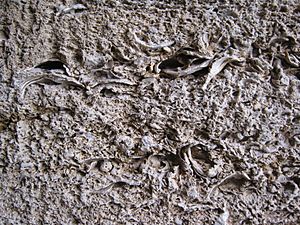Chipiona Lighthouse facts for kids
| Location | Chipiona Province of Cádiz Andalusia Spain |
|---|---|
| Coordinates | 36°44′16.51″N 6°26′32.05″W / 36.7379194°N 6.4422361°W |
| Year first constructed | 1867 |
| Construction | cut stone tower |
| Tower shape | tapered cylindrical tower with balcony and lantern |
| Markings / pattern | unpainted tower, white trim, grey lantern roof |
| Height | 205 feet (62 m) |
| Focal height | 226 feet (69 m) |
| Range | 25 nautical miles (46 km; 29 mi) |
| Characteristic | Fl W 10s. |
| Spain number | ES-09180 |
The Chipiona Lighthouse (also called Faro de Chipiona in Spanish) is a very old and important lighthouse in Chipiona, Spain. It was built in the 1800s. This lighthouse is one of the tallest "traditional lighthouses" in the world. It is also the tallest lighthouse in all of Spain! You can find it on a piece of land called Punta del Perro, which sticks out into the Atlantic Ocean. Its bright light helps ships find their way to Seville.
Contents
A Look Back: History of the Chipiona Lighthouse
Ancient Roman Lighthouse
Did you know there was a lighthouse here even before the current one? A very old lighthouse stood on this same spot during the Roman period. This ancient lighthouse was so amazing that people compared it to the famous Lighthouse of Alexandria.
A Roman leader named Quintus Servilius Caepio ordered it built around 140 BC. He wanted to help ships avoid a dangerous reef near the mouth of the Guadalquivir River. The Roman name for this tower was Turris caepionis, which means "Caepio's Tower." Many people believe this is where the name Chipiona comes from!
Building the Modern Lighthouse
The idea for the modern Chipiona Lighthouse started in 1862. An engineer from Catalonia, Spain, named Jaime Font designed it. The first stone was placed on April 30, 1863. The lighthouse's light shone for the very first time in 1867.
Since then, the light has only been turned off two times. The first time was in 1898. This was during a war between Spain and the United States of America. People worried about an invasion, so all lighthouses around Cadiz were turned off. The second time was during the Spanish Civil War in 1936. The light stayed off for three years during that conflict.
In December 1999, the lighthouse got a new, brighter light. This new light uses a special halogen lamp. It can be seen from about 129 kilometers (80 miles) away! The light flashes once every ten seconds.
How the Chipiona Lighthouse Was Built
The Chipiona Lighthouse looks a bit like an old Roman column. It gets slightly narrower as it goes up. It was built using strong blocks of sandstone and a special rock called oysterstone.
Oysterstone is a type of limestone. It has visible pieces of mollusc shells, especially oyster shells, inside it. This type of rock is often used in towns and cities along the southwest coast of Spain.
At the very top of the lighthouse, there is a walkway called a gallery. Above this gallery is the lantern room, where the bright light shines from. The base of the lighthouse is a square building with four floors. In front of it is a two-story house, painted white, where the lighthouse keeper used to live.
You can visit the lighthouse! The area around it is open to visitors. You can even take a tour and climb the 344 steps to the balcony below the lantern room. These tours are offered several days a week during the summer. They are available less often during other months.
What the Light Looks Like Now
The Chipiona Lighthouse shows a specific light pattern. It gives one white flash every ten seconds. The light shines from a height of about 226 feet (69 meters). It can be seen by ships up to 25 nautical miles away.
See also
 In Spanish: Faro de Chipiona para niños
In Spanish: Faro de Chipiona para niños
- List of tallest lighthouses in the world
- List of lighthouses in Spain


